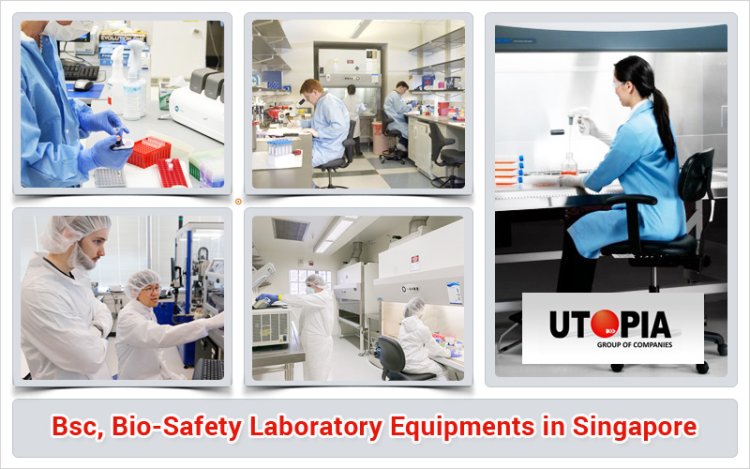Comprehensive Guide to Bio Safety Laboratories: Standards, Design, and Maintenance
Utopia offers biosafety laboratory construction facilities according to WHO BSL1, BSL2, BSL3 & BSL4 and also for Animal BSL1, BSL2, BSL3 & BSL4 guidelines, self-support structure, security system, fire system, disinfection action air-condition system, etc.
Share this Post to earn Money ( Upto ₹100 per 1000 Views )

A Bio Safety Laboratory (BSL) is a specialized facility crucial for the safe handling and research of potentially hazardous biological agents. The design, construction, and maintenance of these laboratories are guided by stringent international standards and protocols to ensure maximum safety and efficiency. Central to these efforts are guidelines such as the "Biosafety in Microbiological and Biomedical Laboratories" (BMBL) manual and the World Health Organization's (WHO) "Laboratory Biosafety Manual, 4th Edition." Additionally, the Australian/New Zealand Standard AS/NZS 2243.3:2002 on Safety in Laboratories provides essential frameworks for ensuring laboratory safety.
The "Biosafety in Microbiological and Biomedical Laboratories" manual, commonly referred to as the BMBL, is a cornerstone document published by the U.S. Centers for Disease Control and Prevention (CDC) and the National Institutes of Health (NIH). This manual outlines the essential practices, safety equipment, and facility requirements for laboratories working with infectious agents. It categorizes labs into four biosafety levels (BSL-1 to BSL-4), each with specific containment protocols and safety measures based on the agents' risk levels. The guidelines emphasize risk assessment, proper training for personnel, and the implementation of standard operating procedures (SOPs) to mitigate potential hazards.
Complementing the BMBL, the World Health Organization's "Laboratory Biosafety Manual, 4th Edition" offers a global perspective on laboratory biosafety. This manual provides comprehensive recommendations for laboratory design, safety practices, and containment measures. It emphasizes a risk-based approach, advocating for the identification and mitigation of risks associated with specific laboratory activities. The manual also highlights the importance of a biosafety culture, where safety becomes an integral part of the laboratory's operations, ensuring that all personnel are committed to maintaining a safe working environment.
In the context of international standards, the Australian/New Zealand Standard AS/NZS 2243.3:2002 on Safety in Laboratories are a critical document for ensuring laboratory safety in the Australasian region. This standard provides detailed guidelines on the safe handling of hazardous materials, laboratory design, ventilation, and waste management. It also addresses the roles and responsibilities of laboratory personnel, emphasizing the importance of ongoing training and competency assessments.
The lifecycle of a Bio Safety Laboratory encompasses several key stages: pre-design, design, construction, testing and commissioning, and maintenance. Each stage requires careful planning and execution to ensure the laboratory meets the necessary safety and operational standards.
Pre-design
During the pre-design phase, a thorough needs assessment is conducted to determine the laboratory's purpose, the types of agents it will handle, and the biosafety level required. This phase involves consultations with stakeholders, including scientists, engineers, and safety experts, to outline the laboratory's specifications and requirements.
Design
The design phase involves creating detailed architectural and engineering plans that incorporate the necessary safety features and containment measures. This includes specifying materials that are easy to clean and decontaminate, designing effective ventilation systems with HEPA filtration, and planning for the integration of essential safety equipment such as biosafety cabinets and autoclaves.
Construction
Bio-Safety Laboratory Construction phase must be executed with precision, adhering to the design specifications and safety standards. Contractors and construction workers need to be trained in biosafety principles to ensure they understand the importance of following the specified guidelines. Regular inspections and quality control checks are crucial during this phase to ensure compliance with safety standards.
Testing and Commissioning
Once construction is complete, the laboratory undergoes rigorous testing and commissioning to verify that all systems are functioning correctly and meet the required safety standards. This includes validating the performance of ventilation systems, ensuring the integrity of containment barriers, and conducting biosafety training for all laboratory personnel.
Maintenance
On-going maintenance is essential to ensure the laboratory continues to operate safely and efficiently. This includes regular inspections, equipment servicing, and updates to safety protocols as new risks are identified. A comprehensive maintenance plan ensures that the laboratory remains compliant with evolving biosafety standards and continues to protect personnel and the environment.
Bio Safety Laboratories are vital for advancing scientific research while ensuring the safety of researchers and the public. Adherence to guidelines from the BMBL, WHO's Laboratory Biosafety Manual, and AS/NZS 2243.3:2002 is crucial throughout the laboratory's lifecycle, from pre-design to maintenance. By following these standards and best practices, laboratories can effectively manage biohazards and contribute to global health and safety. For more detailed information and assistance with Bio Safety Laboratory design and construction, please contact us.
In addition to adhering to the highest standards in bio safety, Utopia ensures that all facilities are impeccably maintained. We provide high-quality cleaning services utilizing advanced technology cleaning equipment, operated by our team of dedicated employees. Our commitment to excellence ensures that our laboratories not only meet but exceed safety and cleanliness standards, providing a secure and efficient environment for all operations.
In Order To Find Out More Details On Bsc, Bio-Safety Laboratory Equipments Please Be Touch With Us Today Onwards..!
















